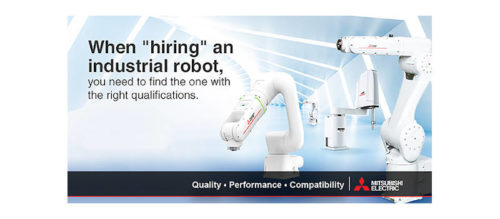Getting the best from your robot investment
Investing in a robot for an automation project is an ongoing process and requires the user to perform risk assessments and get a clear picture of what the robot’s purpose is in the project.
Manufacturers often turn to automation to perform a specific function or address a production line challenge, such as improving productivity or quality. When specifying automation equipment, manufacturers should focus heavily on the goal they want to achieve. Expanding beyond original business objectives or scope can add costs and delays.
For those tackling automation projects, choosing the right robot, software, and tooling is a complex task, and the work doesn’t stop once the robot has been specified. Even if a manufacturer has chosen the right equipment, it doesn’t mean the automation project will be successful. There are numerous considerations to make about the operating environment, machine integration, and peripheral employees before the project begins.
Seeing the bigger picture
Typically, manufacturers take a cellular approach to production. At each stage, the product moves from one cell to the next, so the next step in the process can take place. However, automating one cell impacts far more than just one step in the production process.
The first question to ask is, how will employees be affected? This can include thinking about the process itself, such as whether it will be automated or manual. If the automation displaces human workers, manufacturers should think about new roles for the employees and how to train members of the team how to operate and maintain the equipment. Only when factoring in the role of employees can manufacturers get a clear picture of how long return on investment (ROI) is expected to take.
Employee buy-in is critical when implementing new automation technology. Poor internal communication can lead to employee’s panicking about losing their jobs, due to the misconception robots steal jobs. Clearly explaining what changes will be made and why, will help with this.
Performing risk assessments
Robots commonly perform tasks that are unsafe, repetitive or hazardous for humans. Therefore robots have the potential to improve health and safety, provided the manufacturer conducts a thorough risk assessment.
The risk assessment should cover the equipment and its environment, such as the cell the robot is operating in. Possible hazards include trapping and crushing and, depending on the gripper attached to the robot, electric shocks, burns, or exposure to hazardous substances. By identifying what risks apply, the manufacturer can put control measures in place to reduce the likelihood of each hazard.
Occupational Safety and Health Administration (OSHA) provides guidelines and regulations for employee safety. OSHA draws on the Robotic Industries Association’s (RIA) ANSI/RIA R:15.06-2012, which provides guidelines for manufacturing and integrating robots safely.
There also may be more specific requirements depending on the type of equipment, for example, electrical equipment may be covered by EN 60204-1, which lays out the requirements for enclosures, isolators and actuators. The manufacturer may also have to make physical changes to a building, for example if machine emissions mean different ventilation is required.
Collaborative robot safety
There are additional safety standards around collaborative robots. Traditionally, industrial robots are caged so no human could enter the area while the robot is active. Collaborative robots have been marketed to suggest they are able to work side by side with humans. However, this can only be determined by a risk assessment of the application.
ISO/TS 15066 2016 EN gives additional guidance specific to collaborative robots. This includes defining the spaces around a collaborative robot, so safe operations happen in each area. Manufacturers may want to consider certain collaborative robot safety features, such as safety-rated monitored stop, which means the robot will stop when it detects when a human has entered the collaborative workspace.
Once best practices for integrating, setting up and operating new equipment have been established, it is vital to communicate it to the team. By ensuring staff have a complete understanding of the machinery, the manufacturer reduces the risk of injury. Training can cover processes, procedures and personal protective equipment (PPE).
Maintenance best practices
Though it may seem early days, it is worth considering maintenance at the outset. For a robotic project to generate ROI, it needs to be up and running. Downtime is expensive.
Manufacturers can either purchase equipment that comes with connectivity included or add sensors themselves to measure equipment performance. The data can be analyzed in real-time and used to make decisions. Predictive analytics, for example, will help to flag when equipment is about to break, so maintenance engineers can act in advance.
That said, machines do break. When investing in robotics, manufacturers also should update their obsolescence management strategy, to be prepared in case of a breakdown. Forming a relationship with a reliable supplier means manufacturers can safeguard themselves against potential losses from unplanned downtime — particularly when a costly robot investment is involved.
While investing in robotics is not cheap, they can help automation projects deliver good (ROI), provided all relevant factors are taken into account.
Mark Howard is North America country manager, EU Automation. Edited by Chris Vavra, associate editor, Control Engineering, CFE Media and Technology, cvavra@cfemedia.com.
MORE ANSWERS
Keywords: robotics, robot maintenance, robot safety
Robots aren’t cheap, but they can deliver strong return on investment (ROI) for an automation project.
Risk assessments need to be taken to ensure the robot and human can work without endangering each other.
Manufacturers should also update their obsolescence management strategy when investing in robotics.
Consider this
What is the biggest challenge or hurdle your company faces when it comes to choosing a robot?
Original content can be found at Control Engineering.
Do you have experience and expertise with the topics mentioned in this content? You should consider contributing to our CFE Media editorial team and getting the recognition you and your company deserve. Click here to start this process.




